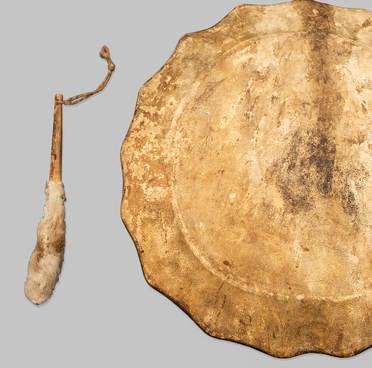A children’s pair of shoes from the collection of the Tobolsk Provincial Museum is sewn by hand with a small oblique seam made of sturgeon skin. Researchers call such shoes plunger-shaped. They consist of the lower part, that is, the plunger, and the shaft sewn thereto. The master connected the parts and stitched them with tendon threads. The plunger was cut out of a single piece of sturgeon skin. It makes up the sole, goes around the foot and toe, and is slightly kilted up on the toe. The top of the shoes is low. The master left the upper section untreated.
Processing of fish skins was mentioned in the annals of the 17th century. They said that Ostyaks ‘… had clothing and shoes made from fish skins, sturgeon, sterlet, burbot, or catfish…’. The peoples of the Siberian North hunted fish without waste. Fish meat was used for food, while fish oil and tripe - for leather and homemade glue. Fish scales were used for clothing, shoes, and other household items. Fish skin had all the necessary qualities for commercial clothing. It is light, strong, protects from the wind, does not get wet, and retains heat well. The skin of individual fish species is several times stronger than other materials. Fish oil or liver, as well as dry ash, were used for fish skin dressing. Shoes made of fish skin are water-resistant and well-breathable.
The fish itself was of great importance in the spiritual life of the Khanty. Everyone had their own spirit. For example, before eating a particular fish, the Khanty asked the spirit to touch the food, and only then they started eating. Fish were divided into male and female species. This was determined by external and internal qualities. Female fish included burbot. It is smooth with a special skin. Sturgeon, sterlet, nelma, and muksun are male species. They should not be cut by a woman, especially sturgeon. Each fish was treated differently. For example, pike was called black and treated with disdain, although they ate it quite often.
The process of making fish skin was laborious and time-consuming. First, the scales were removed from the fish, then the skin was thoroughly cleaned on both sides and washed several times in water, laid out on a smooth surface, and left to dry for a while. The dry fish skin became very hard. To make it softer, the fish skin was crushed for several hours on a special machine with bone knives, but as a result it lost many valuable properties. Now, many traditional crafts of the indigenous peoples of the Khanty and Mansi are almost lost, including the technology of making fish skin.
Processing of fish skins was mentioned in the annals of the 17th century. They said that Ostyaks ‘… had clothing and shoes made from fish skins, sturgeon, sterlet, burbot, or catfish…’. The peoples of the Siberian North hunted fish without waste. Fish meat was used for food, while fish oil and tripe - for leather and homemade glue. Fish scales were used for clothing, shoes, and other household items. Fish skin had all the necessary qualities for commercial clothing. It is light, strong, protects from the wind, does not get wet, and retains heat well. The skin of individual fish species is several times stronger than other materials. Fish oil or liver, as well as dry ash, were used for fish skin dressing. Shoes made of fish skin are water-resistant and well-breathable.
The fish itself was of great importance in the spiritual life of the Khanty. Everyone had their own spirit. For example, before eating a particular fish, the Khanty asked the spirit to touch the food, and only then they started eating. Fish were divided into male and female species. This was determined by external and internal qualities. Female fish included burbot. It is smooth with a special skin. Sturgeon, sterlet, nelma, and muksun are male species. They should not be cut by a woman, especially sturgeon. Each fish was treated differently. For example, pike was called black and treated with disdain, although they ate it quite often.
The process of making fish skin was laborious and time-consuming. First, the scales were removed from the fish, then the skin was thoroughly cleaned on both sides and washed several times in water, laid out on a smooth surface, and left to dry for a while. The dry fish skin became very hard. To make it softer, the fish skin was crushed for several hours on a special machine with bone knives, but as a result it lost many valuable properties. Now, many traditional crafts of the indigenous peoples of the Khanty and Mansi are almost lost, including the technology of making fish skin.

